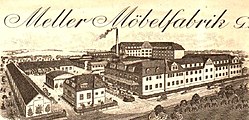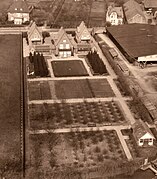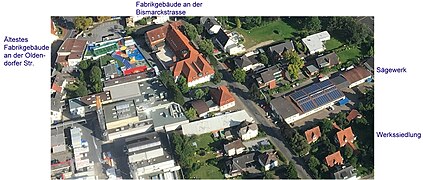Meller furniture factory
| Meller Möbelfabrik GmbH
|
|
|---|---|
| legal form | GmbH |
| founding | 1909 |
| resolution | 1975 |
| Reason for dissolution | insolvency |
| Seat |
Melle , Germany |
| Branch | Furniture industry |
The Meller furniture factory GmbH, Melle (MMM) was a 1870 JH Krumnack, furniture factory, steam sawmill and timber business was established and liquidated after a checkered history in 1975 manufacturer of high quality residential and office furniture in Melle . With up to 200 employees at times, the owner-managed, medium-sized company was an important part of the East Westphalian furniture industry . Some buildings are now listed and well preserved.
history
1870–1908 prehistory
In 1870 the company was in Melle JH Krumnack, furniture factory, steam saw mill and timber business founded. A plot of land near the train station with access via Oldendorfer Strasse was chosen as the location in order to operate nationwide. The first expansion took place in 1904 with the new construction of the three- story factory building that still exists today in classic industrial architecture, as well as an office and residential building. A new machine room followed a few years later .
In 1908, after recent investments , the Krumnack company ran into financial difficulties due to declining sales, which led to bankruptcy proceedings being opened on April 6, 1909 . Up to this point in time, an important supplier was the timber importing company Pundt & Kohn in Geestemünde (today Bremerhaven ). Pundt & Kohn was an important creditor of the Krumnack company through goods delivery credits. For this reason and also out of family interests, the Mell company was taken over by Pundt & Kohn on September 27, 1909 as part of the liquidating foreclosure auction .
1909–1932 Meller Möbelfabrik GmbH
Franz Kohn, owner of the Pundt & Kohn company , had two sons, of whom Hans Kohn continued the timber business in Geestemünde and Gerhard Kohn took over the management of the newly acquired factory in Melle, which was entered in the commercial register in 1909 as Meller Möbelfabrik GmbH with the main business area of furniture production . The sole owner was the general partnership Pundt & Kohn in Geestemünde , in which Gerhard Kohn remained personally liable and authorized signatory.
The few years before the First World War were used to expand furniture manufacturing. When the war broke out, however, production was largely switched to products that were essential to the war effort. Nevertheless, investments were made during the war. For the increased heating demand of the manufacturing rooms and required process heat had to steam boilers to be replaced. So from 1916 to 1918 a new 40 m high clinker chimney and a new boiler house with a chip bunker were built. The factory chimney , a status symbol at the time, was at the time the highest in Melle at 40 meters.
At the beginning of the Weimar Republic and with the economic upturn in the 1930s, expansion progressed rapidly. New buildings for furniture production began as early as 1921 , despite inflation . With the establishment of a new office and the porter's house in 1924, the business address and the main entrance were relocated to Teichbruchstrasse (from 1953 back to Bismarckstrasse). A copper hood with a tower clock from the tower clock factory Ed was mounted on the gatehouse . Korfhage & Sons in Melle / Buer, who also supplied the carillon for the Mell town hall.
In 1925, the company premises were expanded for the construction of a new sawmill on the opposite side of Teichbruchstrasse. This sawmill was equipped with an electrically driven horizontal frame , a large circular saw and a saw sharpening facility. Here, round wood from the surrounding forests was cut for personal use . The most important types of wood were beech , oak , pine and spruce . A short time later, the sawmill was supplemented by an approx. 2500 m² woodshed for air drying the sawn timber . The sawmill, the woodshed and the furniture factory were connected by a narrow-gauge rail system with switches , sliding carriages and turntables on which the loaded goods carts were pushed or pulled by horses .
In 1927 "Haus Sonneck" was built on Meller Berg. The spacious villa with a view over the city of Melle was heated with open chimneys and tiled stoves. An electromagnetic call system was installed for the staff, with which numbers in the kitchen indicated in which room the host or his guests wanted service. The greenhouses, built into the mountainside below the villa, were connected to the cellar of the house by an underground passage.
1933–1945 Operation during National Socialism
The National Socialists strove to increase the productivity of industry. In the course of KdF measures, recreational areas should be set up for employees for work breaks, in order to strengthen the willingness to perform for “Führer, Volk and Vaterland”. At MMM, social rooms were built for this purpose and chestnuts were planted on the corner of Oldendorfer Strasse and Bahnhofstrasse, green spaces were created and wooden benches were set up to linger. In 1939 the Meller furniture factory and the competing furniture factory Gebrüder Kruse were awarded the certificate of a " National Socialist model company ".
In 1937 the family and company name Kohn was changed to Kohnert at the request of Hans Kohn and ministerially approved on August 14, 1937. The reason was hostility because of the Jewish-sounding family name Kohn / Cohn in the context of the National Socialist Aryanization .
The switch to war-essential products was already known from the First World War. During the Second World War, for example, MMM's production was converted to war-essential production. In addition to the manufacture of ammunition boxes, aircraft were also repaired and built in the furniture factory (no further information is available). The managerial staff, if not on the front, was specially retrained for this task. Staff shortages caused by the conscription were compensated for by the use of female workers. Later forced laborers were also assigned to the company. These men and women were quartered on the upper floors of the furniture factory. Under the dispatch department and under the drying chambers, there were cellars that were converted into air raid shelter by installing steel doors .
In 1940 the Meller Möbelfabrik GmbH eV support organization was entered as an association in the commercial register. The purpose is unknown.
1946–1961 economic boom
After the end of the war, the company management was able to achieve an economic boom very quickly . This was made easier by the fact that the factory was not damaged during the war and, of course, there was a great need for furniture. The rapid establishment of a new, comprehensive sales network for the up-and-coming Federal Republic of Germany secured good sales with a loyal clientele. As an exhibitor at the furniture fair in Cologne , which takes place every 2 years, so many orders could be written that afterwards production was always busy for at least 6 months.
Immediately after the end of the war, the "Haus Sonneck" villa was confiscated by the British occupation forces. Gerhard Kohnert therefore had to move temporarily to the MMM office building. Due to this emergency, the construction of new living space began as quickly as possible. In 1949, the construction of the factory housing complex in Bismarckstrasse with the 3 clinker brick houses and large gardens was completed. The middle house No. 15 was occupied by Gerhard Kohnert and house No. 13 by the operations manager and authorized signatory. For family reasons, house no.17 was not to be moved into, but was nevertheless completed as a shell so as not to disturb the symmetry of the residential complex. It was not until 13 years later, after the death of Gerhard Kohnert, who was interior work completed and the house as a company-owned apartment used. Right at the beginning of the occupation, the Sonneck house was modernized by the British by installing a coke central heating system and the expanded tiled stoves were temporarily stored in the MMM. Only after the occupation statute was repealed by the Paris Treaties on May 5, 1955, the villa was released again. However, the house and garden had suffered a lot over the last few years, so that extensive renovation work was necessary before Gerhard Kohnert's nephew's family could move in there. In 1962 the villa was sold for reasons of liquidity.
The production facilities were modernized continuously but not comprehensively in the 1950s. As the last new building, the machine room was expanded in 1956 in order to have more space for the blockboard production . In that year, a profit transfer agreement was signed, which obliged the GmbH to transfer all profits to the parent company in Bremerhaven, which had been weakened by the destruction of the war . The GmbH was financially drained in the following years, and a considerable investment backlog developed .
In 1953, Gerhard Kohnert was awarded the Federal Cross of Merit for his services to building up the domestic furniture industry .
1962–1975 new management
Gerhard Kohnert died on July 5, 1962, after having managed the company as managing partner for 53 years . At its peak, the company had 200 employees and was an important part of the East Westphalian furniture industry . His brother Hans Kohnert from Bremerhaven then took over the management of the company . But he could not stop the economic decline. At the urging of the house banks, Hans Kohnert sold the Meller furniture factory in 1967 to the main creditors in order to forestall bankruptcy. The new managing partners, Hans Wilhelm Rottmann (co-owner of the Rottmann chipboard plant in Herford) and Heinrich Fortmann (previously authorized signatory and operations manager at MMM), first achieved an economic upturn at MMM. In the long run, however, the disadvantages of the outdated factory buildings (three-storey and angled) could not be compensated for by various rationalization measures. The capital was insufficient to reduce the large investment backlog . New competitors also made it more and more difficult to assert oneself in the market and to achieve the necessary prices.
Due to rising costs and stagnating sales , liquidity problems became increasingly apparent as early as 1974 , which then led to insolvency and bankruptcy in 1975 . Production was stopped and the company was liquidated.
building
The buildings that have been preserved from the Meller furniture factory are now in a very well-kept condition. Some are under monument protection. The original gatehouse was unfortunately demolished around 1980.
- The three-story factory building on Oldendorfer Strasse. Built in 1904 in the neo-renaissance style
- The factory building on Bismarckstrasse, used for various offices and practices. Built 1923–1927
- The office building on Bismarckstrasse. Built in 1924 in the style of reform architecture. Today used as the Kingdom Hall of Jehovah's Witnesses
- Villa "Haus Sonneck" was built in 1927 in the style of reform architecture, today it has been heavily changed through renovations and additions
- The street front of the former wooden shed with the arches. Built around 1927 in the neoclassic style
- The three clinker brick houses of the listed factory housing estate in Bismarckstraße, today No. 23, 25 and 27. Built in 1949
Products
- 1909–1930: sanding varnish -, geporte u. Painted bedrooms, dining and living rooms as well as natural lacquered kitchens
- 1930–1939: Elegant varnish, bedroom and daughter rooms as well as natural u. Colored lacquer kitchens
- 1945–1952: Modern kitchens, bedrooms, living rooms and writing cupboards
- 1952–1975: High-quality period furniture , modern living rooms, business and men's rooms as well as office furniture , upholstered furniture and tubular steel armchairs
Meller Möbelfabrik was the owner of several patents for its furniture, for example for a piece of furniture that could be converted into a desk or a special cupboard insert. In the mid-1950s, when book walls became fashionable, MMM had the brand name “ Sokrates Wohnmöbel” protected for these models in order to appeal to educated customers . The name was so impressed by customers that the entire furniture range was soon sold under this name.
The distribution of the furniture was made in the whole of Germany at the wholesale and retail of home furniture, bank facilities and school furniture. Since about 1930 the trademark was used with the MMM placed one above the other. Probably the most prominent end customer was Emperor Haile Selassie of Ethiopia , who bought a study from MMM.
literature
- Oliver Bonkamp: Cooperations and networks in the furniture industry in the Ostwestfalen-Lippe region. Dissertation. University of Paderborn, 2005.
- Grönenberger Heimathefte
Web links
- Family grave of the 'Kohn' family in Bremerhaven-Lehe II Image source: Men from Morgenstern , 2011.
Individual evidence
- ↑ correspondence Kumnack - Punth & Kohn
- ^ Opening letter to bankruptcy proceedings of April 6, 1909
- ↑ Grigo, Sabine (1986): The furniture industry in Grönegau and the neighboring Ravensberg-Lippe. In: Der Grönegau - Meller Jahrbuch, Volume 4, 1986: 46-58
- ^ Opening balance from January 1, 1924
- ^ Rudolf Gerdes (1944): On the history of the Meller economy. In: Archives for regional and folklore of Lower Saxony. Vol. 1944, Issue 23, p. 372; Quoted in: Grove, Thomas (2012): Forced labor and prisoner of war camps in the Melle district. Osnabrück: Der Grönegau , Meller Jahrbuch 2013, Vol. 31, pp. 165, 178
- ↑ A. Ruppert, H. Riechert: The war economy in Lippe . Publications of the State Archives of North Rhine-Westphalia Vol. 41, 2005, pp. 99-149 .
- ^ Support facility Meller Möbelfabrik GmbH eV (No longer available online.) In: Firmenprofil VR 1678 Osnabrück. Archived from the original on January 30, 2016 ; accessed on January 30, 2016 . Info: The archive link was inserted automatically and has not yet been checked. Please check the original and archive link according to the instructions and then remove this notice.
- ↑ Meller Kreisblatt in an article from September 2, 1953.
- ^ Lührmann, H. v. (1924): The Melle industry, its development and its importance. In: Ulrichs, MF (1924): Melle - A small German town. P. 23
- ↑ Chronological print from the Osnabrück commercial register
- ↑ requested "declaration of insolvency. Production in the Melle furniture factory is idle ”. In: Meller Kreisblatt , January 23, 1975.
- ↑ Dipl.-Ing. Eberhard Suß Melle, expert opinion on the material value of MMM from June 24, 1974
- ^ List of monuments of the city of Melle.
- ↑ Patent DE000000964177B : piece of furniture that can be converted into a desk. Registered August 31, 1954 , published May 16, 1957 .
- ↑ Patent DE000001961672U : cabinet insert. Registered December 22, 1966 , published June 8, 1967 .
Coordinates: 52 ° 12 ′ 27 ″ N , 8 ° 20 ′ 27 ″ E














